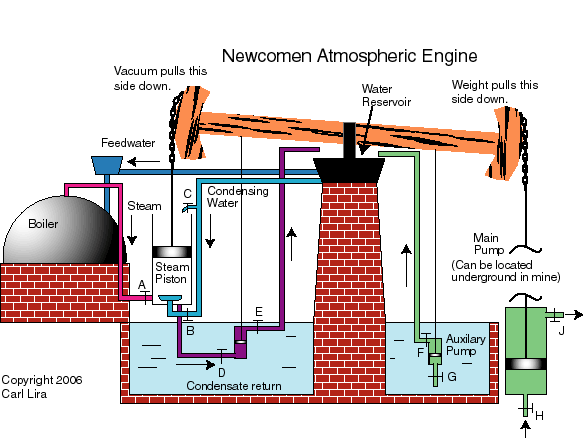
The valves F-J in the main and auxiliary pumps are closed during this step. The pistons pass downward through the liquid, permitting the water to pass from below the piston to above the piston as described on the pump page.
Step 2 - downward stroke of steam piston (downward on left side).
Valves A, D, E are closed, valves B, C, F-J are opened. Water is sprayed into the cylinder below the piston to condense the steam, creating a vacuum inside. The atmospheric pressure on the outside pushes the piston downwards. This action pulls down the beam and fills the main water pump and auxiliary pumps and lifts the water above the pistons. The top of the steam cylinder is open and the steam piston is visible from the top. Water is sprayed onto the top of the piston via valve C to maintain a good seal. Even though Newcomen was a blacksmith, he couldn't make perfectly round cylinders in those days. The cylinders were typically cast and slightly out of round, as well as the pistons! The seal was made by a packing of oakum (hemp fibres soaked in tar) that was jammed in a channel between the piston and cylinder and held in place by weights. Newcomen found it necessary to keep the seal wet in order to maintain the vacuum.
Early Newcomen engines simply drained the condensate water from the steam piston. In the engine illustrated here, a condensate pump is provided that sits in a well that would have been filled with water, presumably pumped from the mine by the main pump. This particular Newcomen engine also has an auxiliary pump to provide condensing water. The internal portion of the water reservoir at the top of the beam support isn't visible from the ground level at the museum, but it probably has separate reservoirs for the hot condensate that returns to the boiler and for the cold condensing water.
The piston chanber and piston had to be reheated on each cycle, unlike as in an internal combustion engine, which limited the efficiency of the engine.
